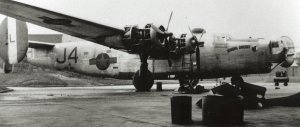3RD STRATEGIC AIR DEPOT
A Brief History of the U.S. Unit at R.A.F. Watton 1943-45
The 3rd Strategic Air Depot (S.A.D.) was one of four S.A.D’s set up under the Bradley Plan. The 3rd S.A.D was the largest (and the best), with 4,800 officers and men. It was responsible for the servicing, maintenance, modifications and repair of all B24 Liberators in the 14 Bomb Groups of the 2nd Air Division. They were responsible for the recovery of all crashed B24’s anywhere in the United Kingdom as well as operating all supply functions for the 2nd Air Division.
The first American contingent arrived at RAF Watton on July 23rd 1943. At this time the station was occupied by the RAF and for a while they shared the base. But as more and more American personnel arrived the RAF began moving out. By October 1943 the last of the RAF had left and Watton became Station 505.
RAF Watton was a standard RAF station designed to accommodate approximately 2,000 men. To cater for the large increase in manpower, a huge complex was built on the South side of the airfield at the village of Griston. It consisted of three T2 aircraft hangers, workshops, supply warehouses, a huge transport division, a hospital, a chapel, a theatre and various clubs as well as living accommodation and messing facilities. An extension was added to the perimeter track with dispersal areas to enable aircraft to reach the hangers and workshops. At the same time the main runway was constructed to take the large B24s. Up to this time Watton had been a grass airfield, since the RAF had used the much lighter twin engine Blenheim.
The Griston complex

By late August 1943, large stocks of Liberator parts had arrived and the engineering section was ready to undertake major work programmes. By early September the supply section was actively engaged in supplying the 2nd Air Division. By January 1944 the 3rd S.A.D. was giving excellent service to the 2nd Air Division and repaired B24s were coming out of the depot daily. On Easter weekend of 1944 the last of the 3rd S.A.D personnel moved from the permanent base to the Griston complex and the permanent base was taken over by the 25th Bomb Group.
To give just two examples of the amount of work they did. During the month of July 1944, eighty eight B24s were repaired at Griston and returned to combat duty. Seventy of these had been battle damaged while the other eighteen needed maintenance. During the week ending June 14th 1944, the supply and transport divisions hauled 3,600 tons of material, mostly high explosives, to the Bomb Groups of the 2nd Air Division.
It has been said that the men of the 3rd S.A.D. knew more about the B24 than did the manufacturers. This claim can quite probably be justified when one hears of the remarkable events that took place at Station 505. To quote just one – the case of the ‘Howling Banshee’. Two B24s of the 458th Bomb Group at Horsham St. Faiths (now Norwich Airport) were joined together after one had lost its entire nose section in a crash and the other had lost its tail in a taxiing accident. Lt. Dick Ayers (of Illinois) decided the two sections could be successfully joined. The task had to be carried out at Horsham since the two sections were too large to be transported to Watton. The two halves were joined together at the centre of the bomb doors. It took a team of twelve men 29 days to complete the work. The inspector found that less than one quarter of the variations allowed at the factory had been used. Captain Henry Miller test-flew the aircraft and not only did it fly perfectly, it cruised at 10 m.p.h. faster than the average B24. This aircraft was named the ‘Howling Banshee’. (Source Martin Bowman “Fields of Little America).

There are many amazing accounts of aircraft being recovered from fields where they had been ditched by their crews. To assist with these ‘short field’ takeoffs Major Witzenburg (senior engineering officer) and Major Tommy Land (chief test pilot) developed a rocket assisted takeoff system by using 8 inch motor rockets they obtained from the Royal Navy. Eight of these rockets were mounted under each wing of a war-weary Liberator and after several test runs they successfully took off using only one quarter of the normal takeoff run. One more takeoff took place for the top brass of the 8th Air Force. After this all drawings and design specifications, details of rockets and timing devices were shipped off to Wright-Patterson Field for evaluation. Unfortunately they were never able to use their brain child in the field – by the time the evaluation had taken place the war had ended.
This brief account merely touches the surface of what the 3rd S.A.D. accomplished, but hopefully gives some insight into what was achieved at Watton.


One correction Griston (Neaton) was Station 505 not RAF WATTON . WATTON was designated Station 376 25th BG P and 801st P occupied the main A/F and quarters .
25th BG (R) reccon, not (P) provisional.
The 801st BG was a Provisional organiztion (P).
See Maurer Air Firce Combat Units of WWII.
PS The 25th BG(R) of WWII was unrelated to the 25thBG(M) of WWII.
The lineages have since been consolidated in modern times, however the lineages and organization were separate during the war.